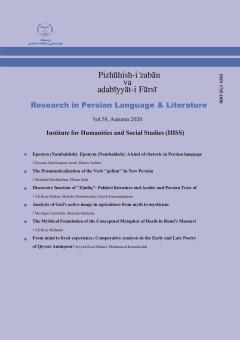-
-
List of Articles
-
Open Access Article
1 - Eponym (Nambakhsh): Eponym (Nambakhsh): A kind of rhetoric in Persian language
hosein ghorbanpoor elmira taslimi -
Open Access Article
2 - The Prammaticalization of the Verb "goftan" In New Persian
Mehrdad Meshkinfam Elham Izadi -
Open Access Article
3 - Discursive function of "Zindiq": Pahlavi literature and Arabic and Persian Texts of
Alireza Heydari Mojtaba Monshizadeh Faezeh Farazandehpour -
Open Access Article
4 - Analysis of God's active image in agriculture from myth to mysticism
mozhgan zarrinfekr maryam salehinia -
Open Access Article
5 - The Mythical Foundation of the Conceptual Metaphor of Death in Rumi's Masnavi
Alireza Shabanlu -
Open Access Article
6 - From mind to lived experience; Comparative Analysis in the Early and Late Poetry of Qeysar Aminpour
seyedreza shakeri Mohammad kamalizadeh
-
The rights to this website are owned by the Raimag Press Management System.
Copyright © 2017-2025







